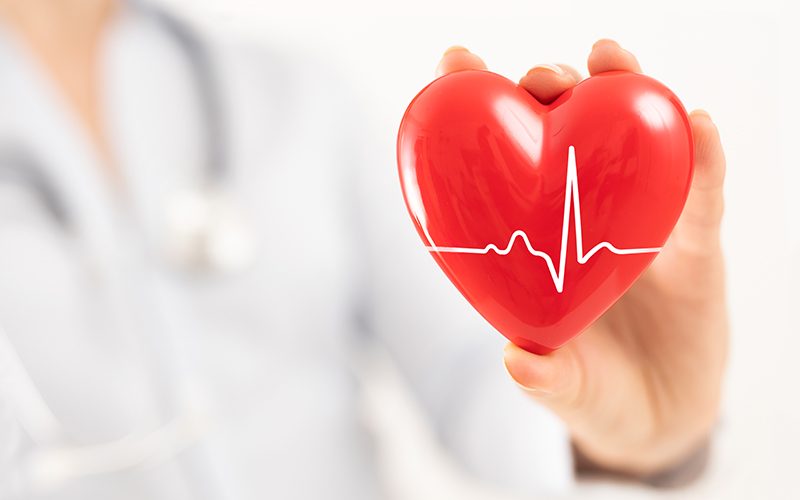

Q1:膽固醇是甚麼?在人體有甚麼作用?
膽固醇屬於血液內其中一種脂肪,是身體中不可缺少的基礎1。膽固醇跟脂蛋白(Lipoprotein)結合後成為脂蛋白膽固醇,經血液循環系統送往身體各部分,以供不同需要1,2。例如,它是細胞膜的主要成分,在不同溫度或環境下調節細胞運作。另外,膽固醇也用作製造分泌酵素或營養素,包括膽汁、維他命D及激素等,幫助身體消化食物及促進骨質健康2,3。

Q2: 膽固醇的來源是甚麼?
我們體內有 70% 膽固醇由肝臟產生,其餘30% 的膽固醇則從進食中獲取4。所以,茹素人士體內也有一定的膽固醇水平5。日常中含有膽固醇的食物主要包括蛋黃、肉類、牛奶製品2。這些食物膽固醇首先經由小腸吸收,並送往肝臟製造膽固醇脂蛋白。雖然身體會自動調節血液膽固醇含量,但攝取過多膽固醇會造成身體負擔2,4。

Q3: 為什麼膽固醇對我們的健康有重大影響?
食物膽固醇可導致血液的膽固醇水平升高,引起各種與心血管系統相關的併發症,甚至足以致命4,6,7。其實,膽固醇可分為「壞膽固醇」(低密度脂蛋白膽固醇,LDL-C)和「好膽固醇」(高密度脂蛋白膽固醇,HDL-C)。兩者之間的分別是,「壞膽固醇」會把膽固醇送往身體不同部位,「好膽固醇」卻能收回身體多餘的膽固醇至肝臟作分解2。若「壞膽固醇」水平過高,血液中過剩的膽固醇會累積在血管,長遠增加患上心血管疾病的風險8。
Q4: 膽固醇引起的心血管疾病是指那些疾病?成因是什麼?
壞膽固醇水平偏高可引起常見的心血管疾病,如冠心病、中風及心肌梗塞7。單單在2019年,香港的心臟病死亡案例就有超過六千宗,當中以冠心病為主9,10。若血液的壞膽固醇水平長期偏高,它與其他發炎因子容易積聚在血管內壁,並引起發炎11。隨時間增長,動脈內壁積聚膽固醇、鈣沉積物及其他免疫細胞等形成斑塊,引致血管壁增厚或硬化,醫學上稱為動脈粥樣硬化11,12。因此,血管變得狹窄甚至完全堵塞,供應心臟肌肉的血液減少,誘發冠心病或心肌梗塞(亦即心臟病發)12。

Q5: 膽固醇的正常標準是多少?是否所有人的膽固醇水平都一樣呢?
根據歐洲心臟協會指引,一般成人的總膽固醇應在 4.0 mmol/L 或以下13。不過,壞膽固醇目標水平則視乎個人心血管疾病風險而定13。以心血管風險評估中屬低風險人士為例,壞膽固醇目標水平應是 3.0 mmol/L 。五十歲以下患有二型糖尿病,病發期少於十年且沒帶有其他風險因素的病友均定為中風險人士,壞膽固醇目標水平是 2.6 mmol/L。至於曾患上心血管疾病的病友則歸類為極高風險人士,其壞膽固醇目標水平應在 1.4 mmol/L,並降至原來的一半以下13。歐美醫學界最新的指引建議,不論心血管疾病風險高低,大家的膽固醇水平都要愈低愈好13,14。

總結:掌握膽固醇知識,保護心血管健康。膽固醇水平降得愈低,罹患心血管疾病的風險也會愈低。
資訊由陳良貴醫生提供
參考資料:
- Cox RA, García-Palmieri MR. Cholesterol, Triglycerides, and Associated Lipoproteins. In: Walker HK, Hall WD, Hurst JW, eds. Clinical Methods: The History, Physical, and Laboratory Examinations. Boston: Butterworths; 1990.
- Vučić V, Cvetković Z. Cholesterol: Absorption, Function and Metabolism. In: Caballero B, Finglas PM, Toldrá F, eds. Encyclopedia of Food and Health. Oxford, UK: Academic Press; 2016: 47-52.
- Lee JH, O'Keefe JH, Bell D, et al. Vitamin D deficiency an important, common, and easily treatable cardiovascular risk factor? J Am Coll Cardiol 2008; 52(24): 1949-1956.
- Kapourchali FR, Surendiran G, Goulet A, et al. The Role of Dietary Cholesterol in Lipoprotein Metabolism and Related Metabolic Abnormalities: A Mini-review. Crit Rev Food Sci Nutr 2016; 56(14): 2408-2415.
- Lütjohann D, Meyer S, von Bergmann K, et al. Cholesterol Absorption and Synthesis in Vegetarians and Omnivores. Mol Nutr Food Res 2018; 62(6): e1700689.
- Division for Heart Disease and Stroke Prevention, Centers for Disease Control and Prevention. (September 08, 2020). High cholesterol facts. Available at: https://www.cdc.gov/cholesterol/facts.htm (Accessed March 30, 2021).
- Mayo Clinic. (July 13, 2019). High cholesterol. Available at: https://www.mayoclinic.org/diseases-conditions/high-blood-cholesterol/symptoms-causes/syc-20350800 (Accessed March 30, 2021).
- American Heart Association. (November 6, 2020). What is cholesterol? Available at: https://www.heart.org/en/health-topics/cholesterol/about-cholesterol (Accessed March 29, 2021).
- Public Health Information System, the Department of Health. (March 17, 2021). Leading Cause of all Deaths. Available at: https://www.healthyhk.gov.hk/phisweb/en/chart_detail/22/ (Accessed March 30, 2021).
- Centre for Health Protection, Department of Health. (November 5, 2019). Heart diseases. Retrieved March 30, 2021, from https://www.chp.gov.hk/en/healthtopics/content/25/57.html.
- Borén J, Chapman MJ, Krauss RM, et al. Low-density lipoproteins cause atherosclerotic cardiovascular disease: pathophysiological, genetic, and therapeutic insights: a consensus statement from the European Atherosclerosis Society Consensus Panel. Eur Heart J 2020; 41(24): 2313-2330.
- Libby P, Buring JE, Badimon L, et al. Atherosclerosis. Nat Rev Dis Primers 2019; 5(1): 56.
- Mach F, Baigent C, Catapano AL, et al. 2019 ESC/EAS Guidelines for the management of dyslipidaemias: lipid modification to reduce cardiovascular risk: The Task Force for the management of dyslipidaemias of the European Society of Cardiology (ESC) and European Atherosclerosis Society (EAS). Eur Heart J 2019; 41(1): 111-188.
- Grundy SM, Stone NJ, Bailey AL, et al. 2018 AHA/ACC/AACVPR/AAPA/ABC/ACPM/ADA/AGS/APhA/ASPC/NLA/PCNA Guideline on the Management of Blood Cholesterol: Executive Summary: A Report of the American College of Cardiology/American Heart Association Task Force on Clinical Practice Guidelines. J Am Coll Cardiol 2019; 73(24): 3168-3209.
為鼓勵市民認識健康資訊,本文章由 安進香港支持製作
HK-06438-REP-2021-Jun


